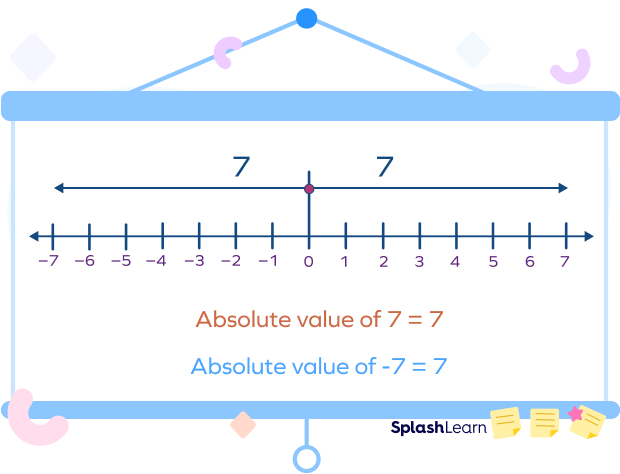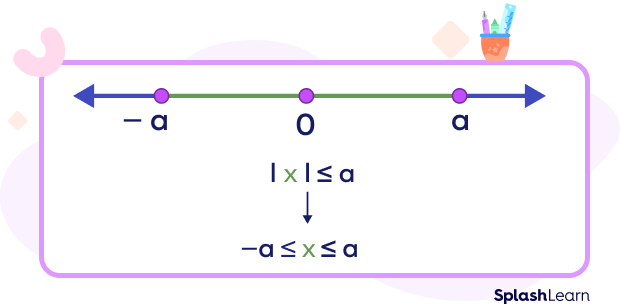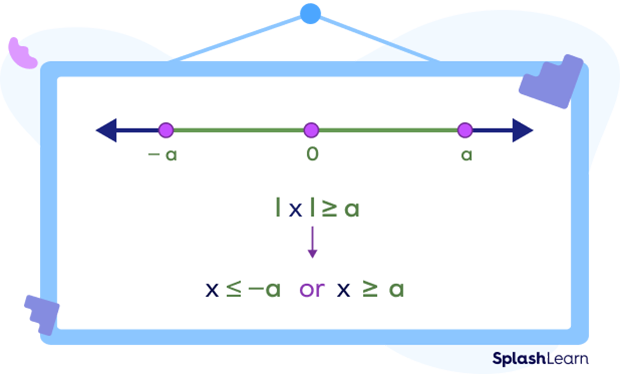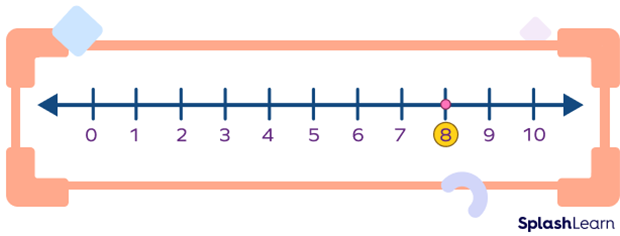What Is the Absolute Value of a Number?
The absolute value of a number tells us how far a given number is from the origin on a number line.
The absolute value only talks about distance, and not direction. We know that distance is a non-negative quantity. Thus, the absolute value of a number can never be negative.

So, what does absolute value mean? Observe the diagram. Here, we can see that
7 is 7 units to the right of 0.
Thus, the absolute value of 7 is 7.
-7 is 7 units to the left of 0.
Thus, the absolute value of -7 is 7.
Recommended Games
Absolute Value: Definition
Absolute value of a number can be defined as the distance of the number from the origin on a number line.
Recommended Worksheets
Absolute Value: Symbol
Absolute value of a number is represented by writing the number between two vertical bars. Note that the vertical bars are not to be confused with parentheses or brackets.
The absolute value of x is represented by |x|, and we read it as “absolute value of x.” It is also read as “modulus of x.” Sometimes, the absolute value of a number n is also written using the notion “abs(n).”
In the previous example, we can write
$|7| = | \;–\; 7| = 7$
How to Find the Absolute Value of a Number
The absolute value of a positive number is the number itself. The absolute value of a negative number is written as the numeric value ignoring the negative sign. The absolute value of 0 is 0.
Absolute Value of 0
The distance of the point zero from zero is 0 itself. Thus, the absolute value of 0 is 0.
Absolute Value Properties
Non negativity: Absolute value of a number is always non-negative.
$ | n | \ge 0$
Symmetry: The absolute value of a number equals the absolute value of its additive inverse.
$| \;-\; x | = | x |$
Positive definiteness: Absolute value of a number is 0 only if the number is 0.
$| n | = 0$ if and only if $n = 0$
On the same lines, we can say that $| x \;–\; y | = 0 ↔ x = y$
Multiplicativity: The absolute value of the product of two numbers is the product of the absolute values of the individual numbers.
$|x\times y| = | \times | \times | y |$
Preservation of division (equivalent to multiplicativity):
$|\frac{x}{y}| = |\frac{x}{y}| …y \neq 0$
Sub-additivity: The absolute value of the sum of two numbers is less than or equal to the addition of the absolute values of the individual numbers.
$|x + y| \le | x | + | y |$
Equivalent to sub-additivity: $| x \;–\; y | \ge | | x | \;–\; | y | |$
Triangle inequality (equivalent to subadditivity): $| x \;–\; y | \le | x \;–\; z | + | z \;–\; x |$
Idempotence: The absolute value of an absolute value of a number is simply the absolute value.
$| | x | | = | x |$
Absolute Value Inequalities
Let’s discuss two important absolute value inequalities.
- $| x | \le a ⇔ \;−\; a \le x \le a$
This is often referred to as AND inequality.
Example: $|x \;−\; 5| \le 7 ⇔ \;−\;7 \le x \;−\; 5 \le 7$
$⇔ \;−\; 2 \le x \le 12$

- $| x | \ge a ⇔ x \le \;−\; a\; or\; x \ge a$
This is often referred to as OR inequality.
Example: $| x | \ge 3 ⇔ x \le \;−\;3$ or $x \ge 3$

Absolute Value of Real Numbers
The absolute value of a positive real number is the number itself. The absolute value of a negative real number is the number without a negative sign. The absolute value of 0 is 0.
Thus, for a real number x, the absolute value is given by:
$| x | = x$ if $x \ge 0$
$| x | = \;–\; x$ if $x \lt 0$
Absolute Value on a Number Line
As mentioned earlier, the absolute value of a number tells us the distance of a number from zero on a number line.
It is easy to understand the absolute value of integers (or any number) using the number line.
Example: The absolute value of 8 is 8.
$| 8 | = 8$.
Note that the absolute value of $\;–\; 8$ is also 8.
$| \;–\; 8 | = 8$.

Absolute Value of a Number Examples
- $| 1 | = 1$
- $| \;-\;1| = 1$
- $| 3.5 | = 3.5$
- $| 0 | = 0$
- $| 7.9 | = 7.9$
- $| 5 \;–\; 3 | = | 2 | = 2$
- $| \;–\; 1 + 6 | = | 5 | = 5$
- $| \;–\; 6 \times 2| = | \;–\; 12 | = 12$
Absolute Value Function
The absolute value function can be given by f(x) = |x| such that:
- $| x | = + x$ for $x \gt 0$
- $| x | = \;–\; x$ for $x \lt 0$

Applications of Absolute Value
- To find the distance between two points.
The absolute value of the difference of two real numbers (absolute difference) is the distance between them.

- To identify and remove outliers in data analysis.
- To set tolerance in quality analysis.
- To determine the degree of variation in the data compared from a certain point.
Facts about Absolute Value
- The absolute value of x, denoted by | x |, is also known as “modulus” of x.
- $| x | \lt$ a implies that $\;-\;a \lt x \lt a$
- $| x | \gt$ a implies that $x\lt (\;-\;a)$ or $x \gt a$
Conclusion
In this article, we learned about the absolute value of a number, its symbol, properties, absolute value function, and we also learned its applications. Let’s move ahead and solve a few examples and MCQs based on the concept of absolute value for practice.
Solved Examples on Absolute Value
1. What is the absolute value of $\;–\;18$?
Solution:
The absolute value of a negative number is written as the numeric value, ignoring the negative sign.
The absolute value of $\;-\;18 = |\;-\;18| = 18$
2. Find the value of $-|\frac{\;-\;15}{22}|$.
Solution:
First, focus on the absolute value part.
The absolute value of $\;-\;\frac{15}{22} = |\frac{-15}{22}| = |\frac{15}{22}|$
There’s a minus sign outside the absolute value. It will get tagged along with the answer.
$-|\frac{-15}{22}| = \frac{-15}{22}$
3. Find: $|-9| + |10|$.
Solution:
Here,
|\;-\; 9 = 9|
$|10| = 10$
Thus, $|\;-\;9| + |10| = 9 + 10 = 19$
4. Find the absolute value.
$|5|, |\;-\;11|, |0|, |\;-\;7|, |\;-\;10|$
Solution:
$|5| = 5$
$|\;-\;11| = 11$
$|0| = 0$
$|\;-\;7| = 7$
$|\;-\;10| = 10$
5. Simplify: $|x \;−\; 1| \le 2$
Solution:
$|x \;−\; 1| \le 2$
$\;−\;2 \le x \;−\; 1 \le 2$
$(\;−\;2 + 1) \le x \le (2 + 1)$
$\;−\; 1 \le x \le 3$
Practice Problems on Absolute Value
Absolute Value - Definition, Function, Symbol, Examples, Facts, FAQs
The absolute value of $\;–\; 25$ is ___.
$|\;–\; 25| = 25$
$|11| \times | \;-\; 12| =$ ___
$|11| = 11$
$|\;-\;12| = 12$
$|11| \times | \;-\;12| = 11 \times 12 = 132$
Find the value of $|\frac{-3}{5}| \times |\frac{5}{6}|$
$|\frac{-3}{5}| \times |\frac{5}{6}| = \frac{3}{5} \times \frac{5}{6} = \frac{1}{2}$
$|x \;-\; y| = 0$ if and only if
$|x\;-\;y| = 0$ if and only if $x = y$.
$| 0 | =$
Absolute value of 0 is 0.
The absolute value of 8 is the distance between ____ on a number line.
The absolute value of 8 is the distance between 8 and 0 on a number line.
Frequently Asked Questions about Absolute Value
What is the value of $\;-\;| \;-\; x|$?
$|\;-\;x| = x$
So, $-\; |\;-\;x| = \;-\; x$
How to simplify the absolute value inequality $| x | \le a$?
$| x | \le$ a can be written as a compound inequality $\;−\; a \le x \le a$.
How to simplify the absolute value inequality $| x | \ge a$?
$| x | \ge a$ can be simplified as $x \le \;−\; a$ or $x \ge a$.
Example: $| x | \ge 1$ means $x \le \;−\;1$ or $x \ge 1$.
Can two different numbers have the same absolute value?
Yes, two different numbers can have the same absolute value. The two numbers $\;–\;10$, and 10 have the same absolute value of 10.
$| \;–\; 10 | = | 10 | = 10$.
What is the absolute value of 0?
The absolute value of 0 is always 0 as the distance of 0 from 0 is 0.
What are absolute numbers?
Absolute numbers or absolute values simply refer to numeric values, ignoring the sign of the given numbers.
Why is the absolute value always positive?
Absolute value is a distance, and distance can never be negative. Thus, the absolute value is always positive. To be more accurate, the absolute value is a non-negative number. Absolute value of 0 is 0. 0 is neither positive nor negative. It is considered a non-negative as well as a non-positive integer.
What do absolute value bars mean?
We use a bar on either side of a number to mean absolute value. The absolute value bars or the vertical bars | | represent “modulus symbol.” It gives us the distance of the number from 0.
What are the other names for absolute values?
Absolute value is also commonly referred to as numerical value or magnitude.




































